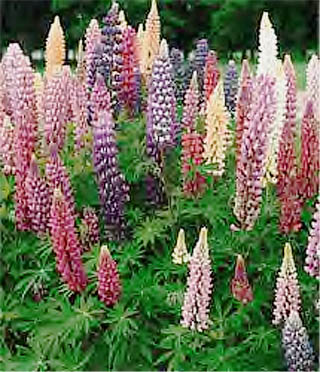
|
|
Cultivated
lupinus (L. polyphyllus)
|
Lupine
- Lupinus Spp.
The
Lupinus are a large genus of handsome plants, annuals, perennials and
shrubs, belong to the Pea family, Leguminosae, represented in Europe,
Asia and North and South America, the poisonous properties of which are
apparently very irregularly and unequally distributed.
A number
of the species are cultivated only as ornamental plants, for their
attractive spikes of pea-like flowers that come in an array of colors,
but others are grown for fodder, and if not over-fed, are found highly
nutritive and wholesome. If the seeds of certain species are eaten in a
more or less mature condition, poisoning is liable to occur, great
numbers of animals sometimes being affected. These poisoning accidents
have occurred in Europe and in the United States.
The species best known - as fodder - is the WHITE LUPIN of cultivation,
Lupinus albus (Linn.), native of Southern Europe and adjacent Asia, a
plant of about 2 feet high, with leaves cut palmately into five or seven
divisions, 1 to 2 inches long, smooth above, and white, hairy, beneath.
The flowers are in terminal racemes, on short footstalks, white and
rather large, the pod 3 to 4 inches long, flattish, containing three to
six white, circular, flattened seeds, which have a bitter taste.
It is probably of Egyptian or East Mediterranean origin, and has been
cultivated since the days of the ancient Egyptians. It is now very
extensively used in Italy and Sicily, for forage, for ploughing-in to
enrich the land, and for its seeds.
The name
lupinus (wolfish) is from the Latin lupus for wolf, refering to
the old and false myth that the deep taproot deprived the soil of
nutrients, actually being a legume it helps restore soil fertility to
poor soils.
This Lupin was cultivated by the Romans as an article of food. Pliny
says: 'No kind of fodder is more wholesome and light of digestion than
the White Lupine, when eaten dry. If taken commonly at meals, it will
contribute a fresh colour and a cheerful countenance.'
Virgil, however, Dr. Fernie tells us (Herbal Simples, 1897), designated
it 'tristis Lupinus,' the sad Lupine. Dr. Fernie further states: 'The
seeds were used as pieces of money by Roman actors in their plays and
comedies, whence came the saying "nummus lupinus" - a spurious
bit of money.'
The YELLOW LUPIN, also a native of Southern Europe and Western
Asia, is called
Lupin luteus from its yellow flowers. The BLUEFLOWERED SPECIES of the
North-eastern United States is Lupinus perennis (Linn.), the WILD or
BLUE BEAN. In the Western United and southward into the Andes, the
species are very numerous.
L.
arboreus (the Tree Lupin), from California and Oregon, will, when well
trained, produce a branching stem several feet in height that will live
through four or five years, forming a trunk of light soft wood of the
thickness of a man's arm.
L. polyphyllus and a few allied species from the same country are tall,
erect, herbaceous perennials with very handsome richlycoloured spikes of
flowers, which have become permanent inmates of our gardens.
If grown from seed, Lupins do not often come true to type, but if
propagated, they will remain true. They must be isolated, owing to
insects which might cross the pollen. Lupins cross readily, hence
isolation for propagation is absolutely necessary. To intensify their
colouring, sulphate of ammonia and sulphate of iron may both be employed.
Climatic conditions also more or less affect their colouring.
The bitter principle Lupinin is a glucoside occurring in yellowish
needles. On boiling with dilute acids, it is decomposed into Lupigenin
and a fermentable glucose.
The bruised seeds of White Lupine, after soaking in water, are sometimes
used as an external application to ulcers, etc., and internally are said
to be anthelmintic, diuretic and emmenagogue.
In 1917 a 'Lupin' banquet was given in Hamburg at a botanical gathering,
at which a German Professor, Dr. Thoms, described the multifarious uses
to which the Lupin might be put. At a table covered with a tablecloth of
Lupin fibre, Lupin soup was served; after the soup came Lupin beefsteak,
roasted in Lupin oil and seasoned with Lupin extract, then bread
containing 20 per cent of Lupin, Lupin margarine and cheese of Lupin
albumen, and finally Lupin liqueur and Lupin coffee. Lupin soap served
for washing the hands, while Lupin-fibre paper and envelopes with Lupin
adhesive were available for writing.
Source:
http://www.botanical.com/botanical/mgmh/l/lupins50.html
